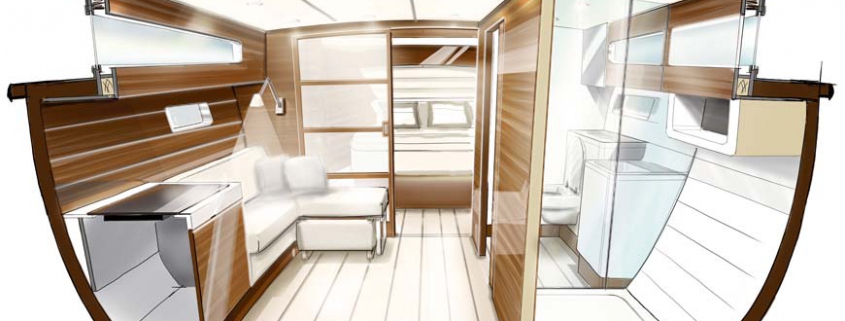
Yacht architects have a lot of responsibility. Not only do our members need to design a yacht with beautiful lines and form, but it must also have excellent sailing capabilities and meet all of the demands of the various institutions, so that the owner and his crew and guests can safely sail the seas of the world.
Responsibilities
Before building begins, the architect develops a design process. This lays out the lines and form, the construction and everything related to strength, stability, propulsion and sailing behavior (speed, maneuverability and wave behavior). Leading in this are the safety and comfort of the passengers.
The architect takes mainly the wishes of the client into account, but must also meet relevant criteria of the regulatory authorities such as the classification societies requirements and CE-rules on aspects of stability, strength and safety.
During the course of the tender process, the architect will compile the building specification and will help with selecting the shipyard and the negotiation of the contract between the owner and the shipyard. He will also implement the design details, providing the specifications for the pre-cut package for the hull and the mechanical engineering systems (e.g. propulsion system, fuel system, fresh-, bilge-, gray- and black water systems, heat and air conditioning, etc.). Calculations and drawings together form the complete blueprint for building the yacht.
During the entire building process the yacht architect supervises the progress and guides the build. He monitors the builder’s progress and ensures the design is correctly implemented with regard to the specifications, drawings and calculations that were provided to the shipyard. Upon completion, the yacht architect will be present during the trial run of the yacht, followed by the delivery to the client.
Education
During his education, the yacht architect develops the knowledge that he needs in order to produce the calculations and drawings that are the framework of the design. It is possible to follow these studies at the technical university (TU) Delft , or one of the other Higher Professional Education Institutes (HBO) (Delft, Leeuwarden and Rotterdam). In the years following, the yacht architect will further develop his practical knowledge while working for more experienced members of the NBJA. The training for Naval Architecture / marine technology at the Delft Technical University is primarily focused on the theoretical basis of the trade, while the Higher Professional Education Institutes are divided into a mix of theory and practice that is more aimed at the daily responsibilities of a yacht architect. During his study, the yacht architect will have completed various internships to develop necessary practical experience.
As a rule, the thesis is conducted in co-operation with a yacht architect or a naval architecture bureau.
This thesis, which is often focused on a specific design or part of a design, will have taught the yacht architect a specialized field. Once his education has been successfully completed, the yacht architect is granted the title of Ir, Ing, M. Sc., or B. Eng., depending on the study and the education institute. At the moment there are four different studies in the Netherlands:
- NHL higher professional education institute: Marine Technology Naval Architecture
- Rotterdam higher professional education institute: Naval Architecture Marine Technology
- STC-Group: higher professional education institute HBO Naval Architecture / Marine Technology
- TU Delft: Marine Technology
